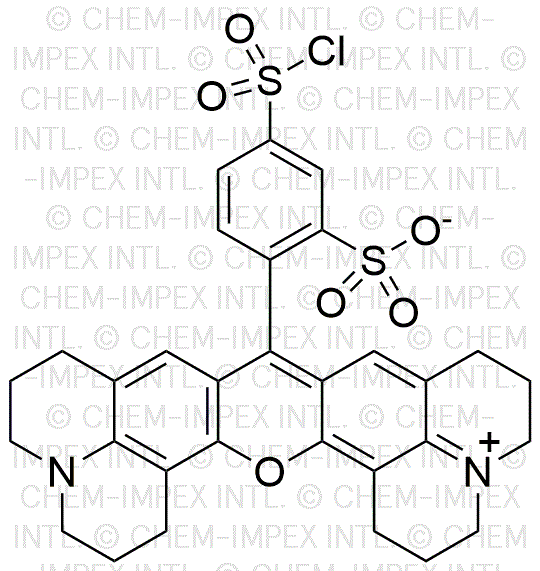Sulforhodamine 101 acid chloride is widely utilized in research focused on:
- Fluorescent Labeling: This compound is commonly used to label proteins and nucleic acids in biological research, allowing scientists to visualize cellular processes under a fluorescence microscope.
- Imaging Techniques: It plays a crucial role in various imaging techniques, such as fluorescence microscopy and flow cytometry, enhancing the detection sensitivity of biological samples.
- Drug Development: In pharmaceutical research, it is used to study drug interactions and cellular uptake, helping researchers understand the efficacy and mechanism of action of new drug candidates.
- Environmental Monitoring: The compound is applied in environmental science for tracking pollutants and studying their effects on ecosystems, providing valuable data for environmental protection efforts.
- Diagnostic Applications: Sulforhodamine 101 acid chloride is utilized in developing diagnostic assays, particularly in cancer research, where it helps in identifying tumor markers and monitoring treatment responses.
Informations générales
Propriétés
Sécurité et réglementation
Applications
Sulforhodamine 101 acid chloride is widely utilized in research focused on:
- Fluorescent Labeling: This compound is commonly used to label proteins and nucleic acids in biological research, allowing scientists to visualize cellular processes under a fluorescence microscope.
- Imaging Techniques: It plays a crucial role in various imaging techniques, such as fluorescence microscopy and flow cytometry, enhancing the detection sensitivity of biological samples.
- Drug Development: In pharmaceutical research, it is used to study drug interactions and cellular uptake, helping researchers understand the efficacy and mechanism of action of new drug candidates.
- Environmental Monitoring: The compound is applied in environmental science for tracking pollutants and studying their effects on ecosystems, providing valuable data for environmental protection efforts.
- Diagnostic Applications: Sulforhodamine 101 acid chloride is utilized in developing diagnostic assays, particularly in cancer research, where it helps in identifying tumor markers and monitoring treatment responses.
Documents
Fiches de données de sécurité (FDS)
La FDS fournit des informations de sécurité complètes sur la manipulation, le stockage et l’élimination du produit.
Spécifications du produit (PS)
Le PS fournit une description complète des propriétés du produit, notamment sa composition chimique, son état physique, sa pureté et les exigences de stockage. Il détaille également les plages de qualité acceptables et les applications prévues du produit.
Certificats d'analyse (COA)
Recherchez des certificats d'analyse (COA) en saisissant le numéro de lot du produit. Les numéros de lot et de lot se trouvent sur l'étiquette d'un produit, après les mots « Lot » ou « Lot de fabrication ».
Numéro de catalogue
Numéro de lot/série
Certificats d'origine (COO)
Ce certificat d'exploitation confirme le pays dans lequel le produit a été fabriqué, et détaille également les matériaux et composants utilisés et s'il est issu de sources naturelles, synthétiques ou autres sources spécifiques. Ce certificat peut être requis pour les douanes, le commerce et la conformité réglementaire.
Numéro de catalogue
Numéro de lot/série
Fiches de données de sécurité (FDS)
La FDS fournit des informations de sécurité complètes sur la manipulation, le stockage et l’élimination du produit.
DownloadSpécifications du produit (PS)
Le PS fournit une description complète des propriétés du produit, notamment sa composition chimique, son état physique, sa pureté et les exigences de stockage. Il détaille également les plages de qualité acceptables et les applications prévues du produit.
DownloadCertificats d'analyse (COA)
Recherchez des certificats d'analyse (COA) en saisissant le numéro de lot du produit. Les numéros de lot et de lot se trouvent sur l'étiquette d'un produit, après les mots « Lot » ou « Lot de fabrication ».
Numéro de catalogue
Numéro de lot/série
Certificats d'origine (COO)
Ce certificat d'exploitation confirme le pays dans lequel le produit a été fabriqué, et détaille également les matériaux et composants utilisés et s'il est issu de sources naturelles, synthétiques ou autres sources spécifiques. Ce certificat peut être requis pour les douanes, le commerce et la conformité réglementaire.


